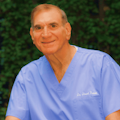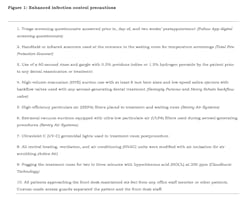Dentistry is completely safe with enhanced infection control: Results of a new multicenter study
Background
The World Health Organization (WHO) declared COVID-19 a pandemic on March 11, 2020.1 While this virus has affected all aspects of life and business in the United States, its potential effect on the practice of dentistry may be the most dramatic.
Transmission of this virus via an airborne route in the dental office has been proposed as routine dental procedures involve aerosol generation.2 Because severe acute respiratory syndrome coronavirus 2 (SARS-CoV-2), the virus that causes COVID-19, can be aerosolized with a potential for an airborne route of transmission, dentistry and dental hygiene were listed as two occupations with the most risk of contracting the SARS-CoV-2 virus.3 In a statement on interim guidance released on August 11, 2020, the WHO recommended that all routine dental procedures be delayed until COVID-19 transmission rates decrease from community transmission to cluster cases and the risk of transmission in a dental office can be studied and evaluated.4
As we are currently witnessing a resurgence of COVID-19–positive cases with possible second and third wave peaks of infection, the potential for community transmission remains high for an uncertain period of time. The need for research to demonstrate that safe dentistry can be delivered while COVID-19 cases are high is important, as the timeline for the development of an effective vaccine remains unknown.
The purpose of this article is to review a new multicenter retrospective study on the incidence of transmission of the SARS-CoV-2 virus during a six-month time period of the pandemic, which included assessing patient risk for COVID-19 disease severity as related to comorbidities in their medical history.5 The difference between aerosol-generating medical procedures (AGMP) and aerosol-generating dental procedures (AGDP) will be briefly addressed. Finally, infection control protocols and specialized equipment dedicated to airborne precautions used during this study will be discussed.
Study
Three New York dental offices with two periodontists and three hygienists treated 2,810 patients during a six-month time period from March 1, 2020, to September 15, 2020. Of those, 1,939 (69%) were recorded to be in the high-risk comorbidity (hypertension, diabetes, 65 years of age or older, immune dysregulation, and/or a history of immunosuppressive medication). Various dental treatment was administered during this study period that included aerosol-generating procedures. Control systems were put in place that included staff training, patient screening, strict adherence to standard operating infection protocols, distancing appointments, mask use, air purification, air filtration, ventilation, operatory sanitization with HOCL and UVC light, and proper personal protective equipment (PPE) use as directed by the Centers for Disease Control and Prevention (CDC) and the Occupation Safety and Health Administration (OSHA). Refer to Figure 1.
These control systems resulted in a zero transmission rate from patient to health-care worker or health-care worker to patient as signified by the absence of any COVID-19 symptoms from office staff and patients during the six-month period of this study. If the patient did not present to the dental office for a two-week posttreatment exam and to ascertain symptom status, the asymptomatic status was obtained by contact via a phone call, text, email, or dental follow-up application. Seventy-three patients called the office prior to their scheduled dental appointments upon receiving the office screening questionnaire to report they tested positive for COVID-19. None contracted the virus in any of the three dental offices followed in the study. Three staff members, each working at a different office, contracted COVID-19 during the time period of emergency treatment only and while they were furloughed and not working.
Discussion
Although there has been anecdotal social media sharing of dental offices that have had staff members develop COVID-19, the etiology and tracing of those infections were not clear. In a recent survey of 2,195 dentists conducted by the American Dental Association, less than 1% (20) had suspected or probable COVID-19 infections.7 The potential for viral transmission in a dental office is low and a distinction must be made from AGMP and AGDP. AGMP are those procedures that agitate the airway (e.g., tracheal or bronchial intubation) and may induce the patient to cough forcibly, thereby releasing aerosols filled with a high viral infectious dose.8 On the other hand, AGDP are dental procedures that produce aerosols during instrument vibration, rotation, and air compression when contacting oral fluid.
Oral secretions and nasal fluid usually have lower viral concentrations than chest secretions. AGDP are often accompanied by high-volume evacuation and/or other filtration devices that may be absent during AGMP. These suction techniques lower an already low potential for transmission in the dental environment. Control systems using ventilation, intraoral or extraoral suctions, and full PPE still need to be employed, as the dental health-care worker can encounter secretions with high viral load via a cough or sneeze.9
In conclusion, during the six-month period of working in all three of the dental offices during the height of the COVID-19 pandemic in New York, no dentists, staff members, or patients who were treated during this time contracted SARS-CoV-2. Of the patients, 69% had high-risk comorbidities, showing that dental care can be administered safely even in high-risk patients.10
Editor’s note: This article originally appeared in Perio-Implant Advisory, a newsletter for dentists and hygienists that focuses on periodontal- and implant-related issues. Perio-Implant Advisory is part of the Dental Economics and DentistryIQ network. To read more articles, visit perioimplantadvisory.com and subscribe at this link.
References
- WHO director-general’s opening remarks at the media briefing on COVID-19 – 11 March 2020. World Health Organization. March 11, 2020. https://www.who.int/dg/speeches/detail/who-director-general-s-opening-remarks-at-the-media-briefing-on-covid-19---11-march-2020
- Peng X, Xu X, Li Y, Cheng L, Zhou X, Ren B. Transmission routes of 2019-nCoV and controls in dental practice. Int J Oral Sci. 2020;12(1):9. doi:10.1038/s41368-020-0075-9
- Lu M. The front line: Visualizing the occupations with the highest COVID-19 risk. Visual Capitalist. April 15, 2020. https://www.visualcapitalist.com/the-front-line-visualizing-the-occupations-with-the-highest-covid-19-risk/
- Considerations for the provision of essential oral health services in the context of COVID-19. Interim guidance. World Health Organization. August 3, 2020. Accessed August 11, 2020. https://apps.who.int/iris/bitstream/handle/10665/333625/WHO-2019-nCoV-Oral_health-2020.1-eng.pdf
- Froum SH, Froum SJ. Incidence of COVID-19 virus transmission in three dental offices: A 6-month retrospective study. Int J Periodontics Restorative Dent. 2020;40(6):853-859. http://quintpub.com/journals/prd/abstract.php?article_id=20874#.X6RW2ZNKiL6
- Harte JA. Standard and transmission-based precautions: an update for dentistry. J Amer Dent Assoc. 2010;141(5):572-581. doi:10.14219/jada.archive.2010.0232
- Estrich CG, Mikkelsen M, Morrissey R, et al. Estimating COVID-19 prevalence and infection control practices among US dentists. J Amer Dent Assoc. 2020;151(11):815-824. doi:10.1016/j.adaj.2020.09.005
- Wölfel R, Corman VM, Guggemos W, et al. Virological assessment of hospitalized patients with COVID-2019. Nature. 2020;581(7809):465-469. doi:10.1038/s41586-020-2196-x
- Chanpong B, Tang M, Rosenczweig A, Lok P, Tang R. Aerosol-generating procedures and simulated cough in dental anesthesia. Anesth Prog. 2020;67(3):127-134. doi:10.2344/anpr-67-03-04
- Richardson S, Hirsch JS, Narasimhan M, et al. Presenting characteristics, comorbidities, and outcomes among 5700 patients hospitalized with COVID-19 in the New York City area. JAMA. 2020:323(20):2052-2059. doi:10.1001/jama.2020.6775
About the Author

Scott Froum, DDS
Editorial Director
Scott Froum, DDS, a graduate of the State University of New York, Stony Brook School of Dental Medicine, is a periodontist in private practice at 1110 2nd Avenue, Suite 305, New York City, New York. He is the editorial director of Perio-Implant Advisory and serves on the editorial advisory board of Dental Economics. Dr. Froum, a diplomate of both the American Academy of Periodontology and the American Academy of Osseointegration, is a volunteer professor in the postgraduate periodontal program at SUNY Stony Brook School of Dental Medicine. He is a PhD candidate in the field of functional and integrative nutrition. Contact him through his website at drscottfroum.com or (212) 751-8530.

Stuart J. Froum, DDS
Stuart J. Froum, DDS, is a clinical adjunct professor and director of clinical research for the Ashman department of periodontology and implant dentistry at New York University Dental Center. He is also in private practice in New York City.



